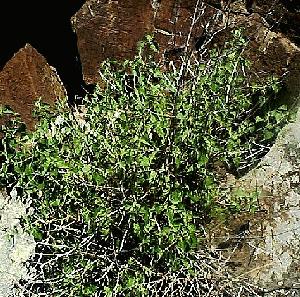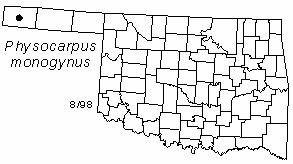 Shrub 1-3 m (3-10 ft) tall. Crown diffuse. Bark dark, peeling. Twigs slender and spreading; stellate hairs on young stems, increasingly glabrous with age. Leaves alternate, ovate to rounded or reniform, 2-4 cm (0.8-1.6 in) long; palmately 3-5 lobed, lobes either rounded or acute, serrate, glabrous or with sparse hairs on both sides; stipules about 0.6 cm (0.3 in) long, membranaceous and deciduous. Flowers terminal corymbs, sparingly pubescent, numerous flowers; about 1 cm (0.4 in) across, calyx campanulate, 5-lobed, lobes about 3 mm (0.1 in) long; petals 5, white; styles 5; stamens 20-40; flowers appear from May to July. Fruits follicles of 2, typically united above the middle, yellow-brown and lustrous; 1-3; fruits mature May to July.
Shrub 1-3 m (3-10 ft) tall. Crown diffuse. Bark dark, peeling. Twigs slender and spreading; stellate hairs on young stems, increasingly glabrous with age. Leaves alternate, ovate to rounded or reniform, 2-4 cm (0.8-1.6 in) long; palmately 3-5 lobed, lobes either rounded or acute, serrate, glabrous or with sparse hairs on both sides; stipules about 0.6 cm (0.3 in) long, membranaceous and deciduous. Flowers terminal corymbs, sparingly pubescent, numerous flowers; about 1 cm (0.4 in) across, calyx campanulate, 5-lobed, lobes about 3 mm (0.1 in) long; petals 5, white; styles 5; stamens 20-40; flowers appear from May to July. Fruits follicles of 2, typically united above the middle, yellow-brown and lustrous; 1-3; fruits mature May to July.
Distribution: Texas and New Mexico, west to Arizona Arizona and north to South Dakota. Restricted to northwest Cimarron County in Oklahoma.
Habitat: exposed, well drained rocky slopes.
NWI status: UPL, FAC.
Comments: Physocarpus interprets as bladder fruit; monogynus refers to the single style.
Field identification: The two species of ninebark in Oklahoma are well separated geographically; mountain ninebark is found only in Cimarron County, common ninebark (P. opulifolius) is known to occur in Adair County only. Also, mountain ninebark has pubescent carpels.
Horticulture: Propagated from cuttings or seed. First cultivated in 1879.
Wildlife benefits: The fruits are eaten by several species of birds.
Distribution in Oklahoma: 
BACK
NEXT
RETURN TO INDEX
Last update: 10/26/98
 Go to Oklahoma Biological Survey Home Page
Go to Oklahoma Biological Survey Home Page
 Disclaimer
Disclaimer